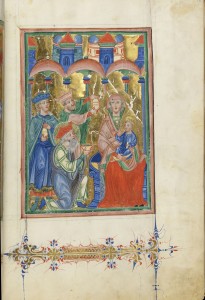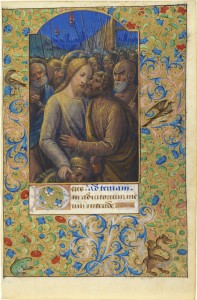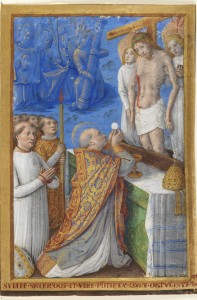Illuminators used gold and silver to create dazzling effects in landscapes, interiors, figures and ornament. These precious metals were employed in two main forms. The first — shell gold or silver — was powdered metal mixed with glue to form a liquid that was applied like paint. Mussel and oyster shells often served as containers for the mixtures, hence the name. Shell gold was used to paint backgrounds, to add accents to night scenes, and to highlight draperies, hair and flesh. Used less often and applied more sparingly, shell silver was employed to depict metal objects, armour and heraldry.
The second form — gold or silver leaf — was metal hammered into tissue-thin sheets which were laid onto the page. The metal could be applied directly to the bare parchment with an adhesive — egg glair or glue made from fish or animals. More often, a preparatory ground of Armenian bole was first applied to the surface of the page. Despite its name, Armenian bole (bolum armenum), a red earth of pinkish colour, was found throughout Europe. Usually mixed with gypsum, it provided a firm ground for the thin gold leaf. Illuminators often applied several layers of bole to create the illusion of thick gold and enhance the three-dimensional effect of their images. Gold leaf was generally polished to produce a brilliant burnished surface and it could be further enhanced by incised or punched patterns. To reduce costs and achieve diverse effects of light and texture, artists also employed other metals, including brass powder, metallic tin, and a tin sulphide known as ‘mosaic gold’ or purpurina.
The use of gold hatching or dots for highlights on draperies, hair and flesh, a technique known as chrysographia, originated in Byzantium. It is characteristic of late medieval and Renaissance illumination. The technique of painting in gold on a monochrome ground, known as camaïeu d’or, was also favoured by late medieval and Renaissance illuminators.


